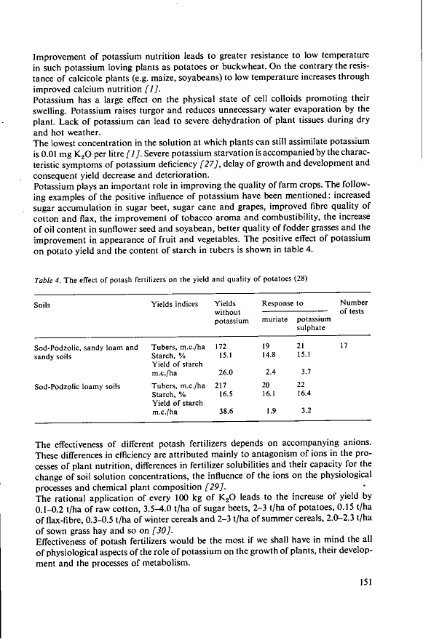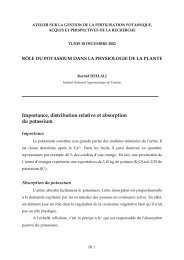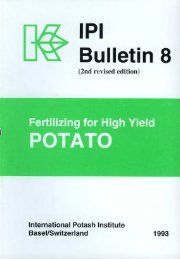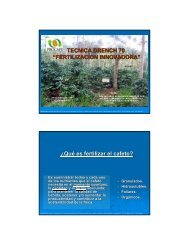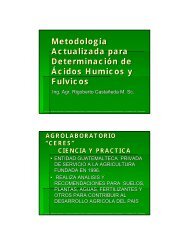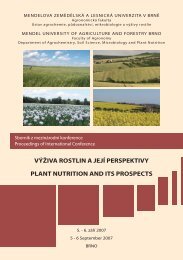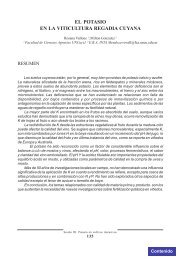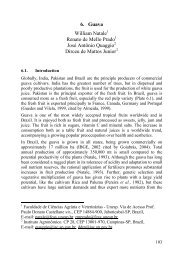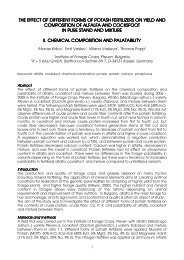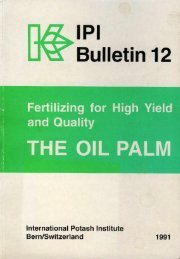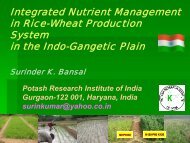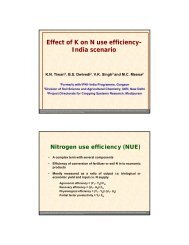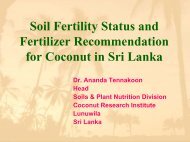Potassium Research and Agricultural Production - The International ...
Potassium Research and Agricultural Production - The International ...
Potassium Research and Agricultural Production - The International ...
Create successful ePaper yourself
Turn your PDF publications into a flip-book with our unique Google optimized e-Paper software.
Improvement of potassium nutrition leads to greater resistance to low temperature<br />
in such potassium loving plants as potatoes or buckwheat. On the contrary the resistance<br />
of calcicole plants (e.g. maize, soya beans) to low temperature increases through<br />
improved calcium nutrition [J].<br />
<strong>Potassium</strong> has a large effect on the physical state of cell colloids promoting their<br />
swelling. <strong>Potassium</strong> raises turgor <strong>and</strong> reduces unnecessary water evaporation by the<br />
plant. Lack of potassium can lead to severe dehydration of plant tissues during dry<br />
<strong>and</strong> hot weather.<br />
<strong>The</strong> lowest concentration in the solution at which plants can still assimilate potassium<br />
is 0.01 mg K 20 per litre [J]. Severe potassium starvation is accompanied by thecharacteristic<br />
symptoms of potassium deficiency [27], delay of growth <strong>and</strong> development <strong>and</strong><br />
consequent yield decrease <strong>and</strong> deterioration.<br />
<strong>Potassium</strong> plays an important role in improving the quality of farm crops. <strong>The</strong> following<br />
examples of the positive influence of potassium have been mentioned: increased<br />
sugar accumulation in sugar beet, sugar cane <strong>and</strong> grapes, improved fibre quality of<br />
cotton <strong>and</strong> flax, the improvement of tobacco aroma <strong>and</strong> combustibility, the increase<br />
of oil content in sunflower seed <strong>and</strong> soya bean, better quality of fodder grasses <strong>and</strong> the<br />
improvement in appearance of fruit <strong>and</strong> vegetables. <strong>The</strong> positive effect of potassium<br />
on potato yield <strong>and</strong> the content of starch in tubers is shown in table 4.<br />
Table 4. <strong>The</strong> effect of potash fertilizers on the yield <strong>and</strong> quality of potatoes (28)<br />
Soils Yields indices Yields Response to Number<br />
without of tests<br />
potassium muriate potassium<br />
sulphate<br />
Sod-Podzolic, s<strong>and</strong>y loam <strong>and</strong> Tubers, m.c./ha 172 19 21 17<br />
s<strong>and</strong>y soils Starch, % 15.1 14.8 15.1<br />
Yield of starch<br />
m.c./ha 26.0 2.4 3.7<br />
Sod-Podzolic loamy soils Tubers, m.c./ha 217 20 22<br />
Starch, % 16.5 16.1 16.4<br />
Yield of starch<br />
m.c./ha 38.6 1.9 3.2<br />
<strong>The</strong> effectiveness of different potash fertilizers depends on accompanying anions.<br />
<strong>The</strong>se differences in efficiency are attributed mainly to antagonism of ions in the processes<br />
of plant nutrition, differences in fertilizer solubilities <strong>and</strong> their capacity for the<br />
change of soil solution concentrations, the influence of the ions on the physiological<br />
processes <strong>and</strong> chemical plant composition [29].<br />
<strong>The</strong> rational application of every 100 kg of K 20 leads to the increase of yield by<br />
0.1-0.2 t{ha of raw cotton, 3.5-4.0 t{ha of sugar beets, 2-3 t{ha of potatoes, 0.15 t{ha<br />
of flax-fibre, 0.3-0.5 t{ha of winter cereals <strong>and</strong> 2-3 t{ha of summer cereals, 2.()"'2.3 t{ha<br />
of sown grass hay <strong>and</strong> so on [30].<br />
Effectiveness of potash fertilizers would be the most if we shall have in mind the all<br />
of physiological aspects of the role of potassium on the growth of plants, their development<br />
<strong>and</strong> the processes of metabolism.<br />
151


